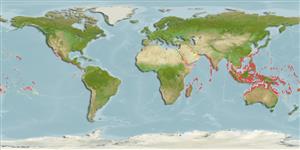>
Ovalentaria/misc (Various families in series Ovalentaria) >
Plesiopidae (Roundheads) > Plesiopinae
Etymology: Plesiops: Greek, plesios = near + Greek, ops = appearance (Ref. 45335); coeruleolineatus: Species name refers to the blue lines present in the dorsal and anal fins.
More on author: Rüppell.
Environment: milieu / climate zone / depth range / distribution range
Écologie
marin récifal; profondeur 1 - 23 m (Ref. 9710), usually 3 - 23 m (Ref. 27115). Tropical; 23°C - 27°C (Ref. 130632); 30°N - 30°S
Indo-Pacific: Red Sea and East Africa to Japan and Oceania.
Taille / Poids / Âge
Maturity: Lm ? range ? - ? cm
Max length : 10.0 cm TL mâle / non sexé; (Ref. 30874)
Épines dorsales (Total) : 10 - 12; Rayons mous dorsaux (Total) : 6 - 8; Épines anales: 3; Rayons mous anaux: 8. Color variable; body generally black or brown; 2 dark stripes behind eye; dorsal spines orange distally; bluish stripe along basal part of dorsal fin (Ref. 5473).
Adults are found under stone or corals in flood basins and lagoons (Ref. 9137). They are common but very secretive and usually found when turning rubble pieces in pools (Ref. 48635). They venture out in the open at night to feed on small crustaceans, fishes and gastropods (Ref. 37816). Eggs are guarded by the male parent (Ref. 205). Minimum depth reported from Ref. 30874.
Life cycle and mating behavior
Maturité | Reproduction | Frai | Œufs | Fécondité | Larves
Eggs are guarded by the male parent (Ref. 205).
Mooi, R.D., 1995. Revision, phylogeny, and discussion of biology and biogeography of the fish genus Plesiops (Perciformes: Plesiopsidae). Life Sci. Contrib. No. 159, 108 p. (Ref. 27772)
Statut dans la liste rouge de l'IUCN (Ref. 130435: Version 2024-1)
Menace pour l'homme
Harmless
Utilisations par l'homme
Pêcheries: sans intérêt; Aquarium: Commercial
Outils
Articles particuliers
Télécharger en XML
Sources Internet
Estimates based on models
Preferred temperature (Ref.
123201): 24.8 - 29, mean 27.8 °C (based on 954 cells).
Phylogenetic diversity index (Ref.
82804): PD
50 = 0.5000 [Uniqueness, from 0.5 = low to 2.0 = high].
Bayesian length-weight: a=0.00468 (0.00175 - 0.01251), b=3.18 (2.95 - 3.41), in cm total length, based on LWR estimates for this (Sub)family-body shape (Ref.
93245).
Niveau trophique (Ref.
69278): 3.6 ±0.3 se; based on diet studies.
Résilience (Ref.
120179): Haut, temps minimum de doublement de population inférieur à 15 mois (Preliminary K or Fecundity.).
Fishing Vulnerability (Ref.
59153): Low vulnerability (10 of 100).
Nutrients (Ref.
124155): Calcium = 134 [70, 220] mg/100g; Iron = 0.737 [0.439, 1.224] mg/100g; Protein = 18.5 [17.4, 19.5] %; Omega3 = 0.105 [0.060, 0.184] g/100g; Selenium = 22.9 [10.7, 46.9] μg/100g; VitaminA = 152 [50, 437] μg/100g; Zinc = 1.81 [1.20, 2.58] mg/100g (wet weight);
